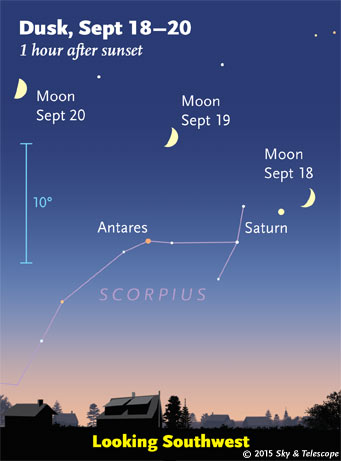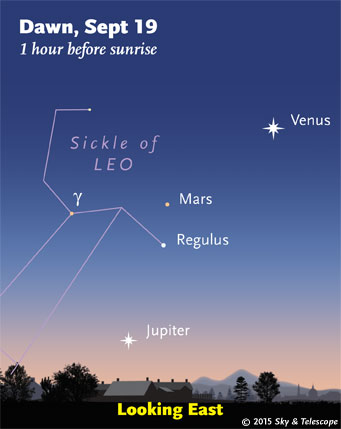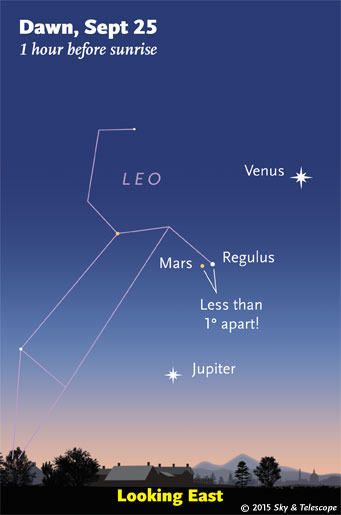


Friday, September 18
• As twilight fades, look low in the southwest for Saturn close to the waxing crescent Moon, as shown here. To their left are Antares and other stars of upper Scorpius.
Saturday, September 19
• The crescent Moon at dusk now forms a triangle with Antares below it and Saturn to their right, as shown here.
Sunday, September 20
• This is the time of year when, during the evening, the dim Little Dipper in the north "dumps water" into the bowl of the Big Dipper way down below it. The Big Dipper dumps it back in the evenings of spring.
Monday, September 21
• First-quarter Moon (exact at 4:59 a.m. Monday morning EDT). This evening the Moon shines above the Teapot of Sagittarius. At this time of year, the Teapot is tipping increasingly far over, as if pouring out the last of summer.
Tuesday, September 22
• The eclipsing binary star Algol should be at minimum brightness, magnitude 3.4 instead of its usual 2.1, for a couple hours centered on 9:20 p.m. EDT according to Algol's recently updated schedule.
Wednesday, September 23
• Binocular observers often scan the rich Milky Way of Cygnus now overhead. But do you know about Omicron1 Cygni? It's a colorful double in the Swan's northwest wing. And a binocular challenge: it's actually triple! See Gary Seronik's Binocular Highlight in the September Sky & Telescope, page 43.
• Autumn begins in the Northern Hemisphere, and spring in the Southern Hemisphere, at the equinox: 4:21 a.m. Wednesday morning EDT (8:21 Sept. 23rd UT). This is when the Sun crosses the equator heading south. Wherever you are, the Sun rises and sets almost exactly due west today.
Thursday, September 24
• Mars gleams less than 1° from Regulus in early dawn this morning and Friday morning. Look east. They're 11° to the lower left of brilliant Venus, as shown here. Binoculars will help as dawn grows bright.
And look for Jupiter 9° or 10° below or lower left of Mars and Regulus.
Friday, September 25
• Look far below the Moon this evening for 1st-magnitude Fomalhaut coming into view. It rises in late twilight. How soon can you first spot it?
• Algol should be at minimum brightness for a couple hours centered on 6:09 p.m. EDT (going by Algol's recently updated schedule). It takes several additional hours to rebrighten.
Saturday, September 26
• With the equinox past and fall under way, Deneb is taking over from Vega as the zenith star at nightfall (for skywatchers at mid-northern latitudes). Look straight up at the end of twilight.
• Get ready for tomorrow night's total eclipse of the Moon! It happens over the Americas, Europe and Africa. Timetables, map, what to watch for. There's more in the September Sky & Telescope, page 26.
Cloudy? We're webcasting the whole lunar eclipse, with commentary by S&T editors and lunar scientists. Tune in!
__________________________
Want to become a better astronomer? Learn your way around the constellations. They're the key to locating everything fainter and deeper to hunt with binoculars or a telescope.
This is an outdoor nature hobby. For an easy-to-use constellation guide covering the whole evening sky, use the big monthly map in the center of each issue of Sky & Telescope, the essential guide to astronomy.

Once you get a telescope, to put it to good use you'll need a detailed, large-scale sky atlas (set of charts). The standards are the little Pocket Sky Atlas, which shows stars to magnitude 7.6; the larger and deeper Sky Atlas 2000.0 (stars to magnitude 8.5); and once you know your way around, the even larger Uranometria 2000.0 (stars to magnitude 9.75). And read how to use sky charts with a telescope.
You'll also want a good deep-sky guidebook, such as Sue French's Deep-Sky Wonders collection (which includes its own charts), Sky Atlas 2000.0 Companion by Strong and Sinnott, the bigger Night Sky Observer's Guide by Kepple and Sanner, or the beloved if dated Burnham's Celestial Handbook.
Can a computerized telescope replace charts? Not for beginners, I don't think, and not on mounts and tripods that are less than top-quality mechanically (meaning heavy and expensive). As Terence Dickinson and Alan Dyer say in their Backyard Astronomer's Guide, "A full appreciation of the universe cannot come without developing the skills to find things in the sky and understanding how the sky works. This knowledge comes only by spending time under the stars with star maps in hand."
This Week's Planet Roundup
Mercury is hidden in the glare of the Sun.
Venus is now at its greatest brilliancy (magnitude –4.8), the "Morning Star" high in the east during dawn. It rises much earlier, around 3 or 4 a.m. depending on your location, a weird UFO of a thing. In a telescope Venus is a thickening crescent, but shrinking in diameter week by week as it pulls farther ahead of Earth around the Sun.
Mars, 400 times fainter at magnitude +1.8, glows 10° or 11° lower left of Venus in early dawn. Regulus, slightly brighter at magnitude +1.4, shines closer below Mars early in the week, and moves up closer to Mars each morning. Regulus passes just 0.8° to the right of Mars on the morning of Friday the 25th.
Jupiter (magnitude –1.7) is even lower in the east during dawn. Look for it 9° below or lower left of Regulus, as shown above.
Saturn (magnitude +0.6, at the Scorpius-Libra border) is moving lower and lower in the southwest at dusk. Left of it by 11° twinkles orange Antares.
Uranus (magnitude +5.7, in Pisces) and Neptune (magnitude +7.8, in Aquarius) are well up in the east and southeast, respectively, by about 10 p.m. They're higher later. Finder charts for Uranus and Neptune.
__________________________
All descriptions that relate to your horizon — including the words up, down, right, and left — are written for the world's mid-northern latitudes. Descriptions that also depend on longitude (mainly Moon positions) are for North America.
Eastern Daylight Time (EDT) is Universal Time (UT, UTC, or GMT) minus 4 hours.
__________________________
“This adventure is made possible by generations of searchers strictly adhering to a simple set of rules. Test ideas by experiments and observations. Build on those ideas that pass the test. Reject the ones that fail. Follow the evidence wherever it leads, and question everything. Accept these terms, and the cosmos is yours.”
— Neil deGrasse Tyson
 0
0
Comments
You must be logged in to post a comment.